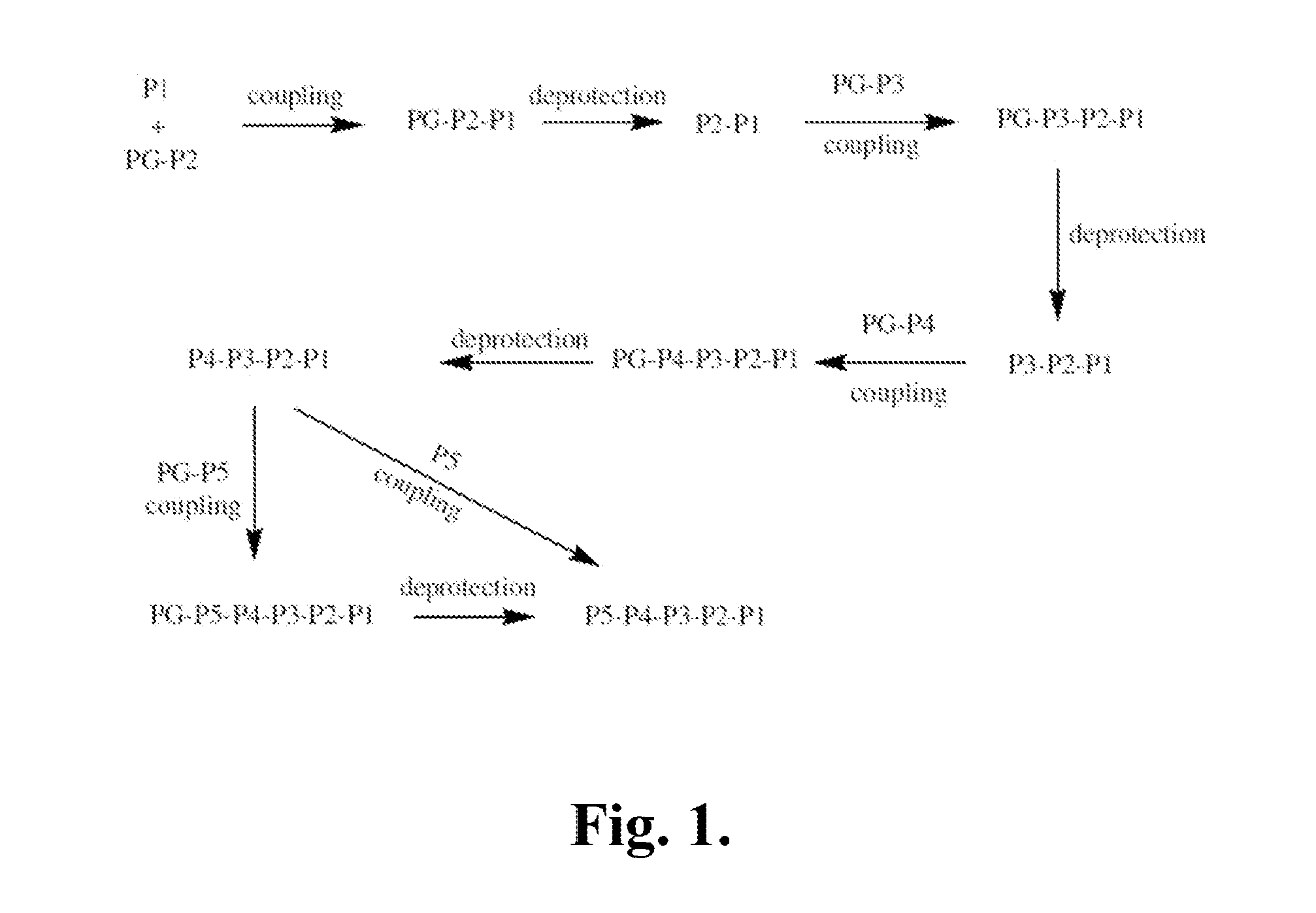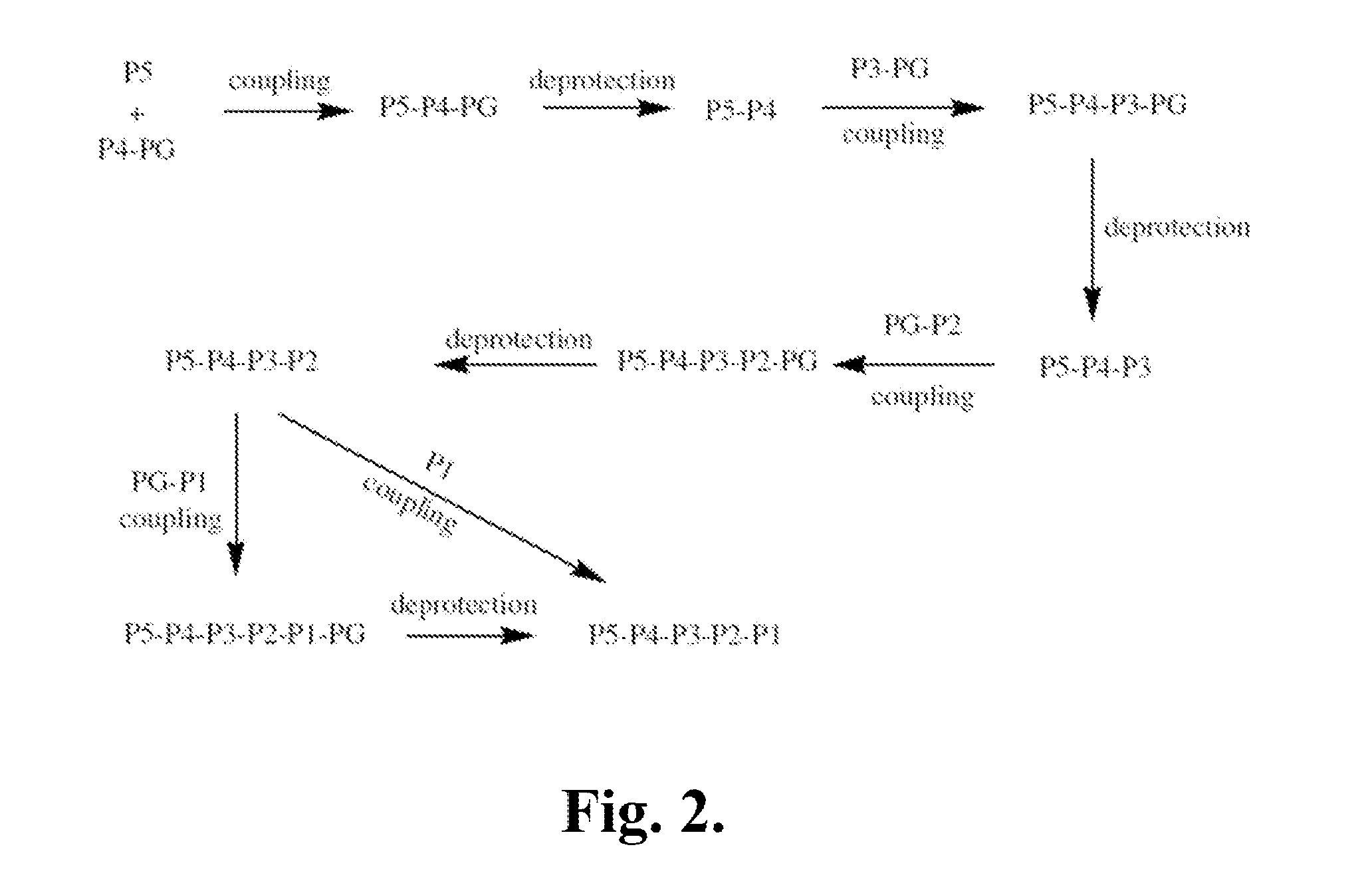Indoline compounds as granzyme b inhibitors
a technology of granzyme b and indoline, which is applied in the direction of peptide/protein ingredients, tetrapeptide ingredients, tripeptide ingredients, etc., can solve the problems of low specificity, low potency or specificity of nonspecific inhibitors such as isocoumarins, and ineffective treatment of granzyme b-related diseases, disorders, and conditions, etc., to reduce the appearance of ageing in the skin, reduce the effect of synthetic complexity/high manufacturing
- Summary
- Abstract
- Description
- Claims
- Application Information
AI Technical Summary
Benefits of technology
Problems solved by technology
Method used
Image
Examples
examples
Synthetic Intermediates
[0468]The following is a description of synthetic intermediates (I-1 to I-15) useful for making representative compounds of the invention.
[0469]Intermediate I-1
tert-Butyl (2S)-2-[(2H-1,2,3,4-tetrazol-5-ylmethyl)carbamoyl]-2,3-dihydro-1H-indole-1-carboxylate (I-1)
[0470]To (2S)-2,3-dihydro-1H-indole-2-carboxylic acid (1 g, 6.13 mmol) in dioxane (6 ml) and NaOH solution (0.5M, 12 ml) was added slowly di-tert-butyl dicarbonate (1.47 g, 6.74 mmol) in dioxane (6 ml) at 0° C. The reaction mixture was warmed to RT and stirred overnight. The reaction mixture was then washed with hexanes (10 ml). The separated water layer was acidified using saturated solution of citric acid and extracted with ethyl acetate (3×15 ml). The organic layer was washed with brine, separated, dried over sodium sulfate and concentrated to give (2S)-1-[(tert-butoxy)carbonyl]-2,3-dihydro-1H-indole-2-carboxylic acid, as light orange colored solid (1.45 g, 90%), used further as described. 1H NMR (4...
example a1
(2S)-1-{2-[(2S,3S)-3-Methyl-2-(2-phenylacetamido)pentanamido]acetyl}-N-(2H-1,2,3,4-tetrazol-5-ylmethyl)-2,3-dihydro-1H-indole-2-carboxamide
[0510]Title compound A1 was prepared from I-5 and I-6 using method A: 1H NMR (400 MHz, DMSO-d6) δ 0.76-0.80 (3H, t, J=8 Hz), 0.82-0.84 (3H, d, J=8 Hz), 1.04-1.11 (1H, m), 1.39-1.45 (1H, m), 1.70-1.76 (1H, m), 3.10-3.14 (2H, d, J=16 Hz), 3.42-3.45 (1H, d, J=8 Hz), 3.53-3.56 (1H, d, J=8 Hz), 3.62-3.65 (1H, m), 3.66-3.69 (1H, m), 4.14-4.16 (1H, t, J=4 Hz), 4.24-4.28 (1H, t, J=8 Hz), 4.47-4.51 (1H, d, J=16 Hz), 4.59-4.63 (1H, d, J=16 Hz), 5.14-5.16 (1H, d, J=16 Hz), 6.97-7.01 (1H, t, J=8 Hz), 7.15-7.30 (7H, m), 8.08-8.11 (1H, d, J=12 Hz), 8.24 (1H, bs), 8.99 (1H, bs), MS (LC / MS) m / z observed 533.05, expected 533.26 [M+H] and observed 555.17, expected 555.24 [M+Na].
example a2
(2S)-1-{2-[(2S,3S)-3-Methyl-2-[2-(pyridin-4-yl)acetamido]pentanamido]acetyl}-N-(2H-1,2,3,4-tetrazol-5-ylmethyl)-2,3-dihydro-1H-indole-2-carboxamide
[0511]Title compound A2 was prepared from I-5 and 4-pyridineacetic acid using method A: 1H NMR (400 MHz, DMSO-d6) δ 0.76-0.80 (3H, t, J=8 Hz), 0.82-0.84 (3H, d, J=8 Hz), 1.04-1.11 (1H, m), 1.38-1.46 (1H, m), 1.71-1.77 (1H, m), 3.07-3.11 (2H, t, J=8 Hz), 3.48-3.61 (2H, m), 4.11-4.15 (1H, d, J=16 Hz), 4.25-4.29 (1H, t, J=8 Hz), 4.39-4.43 (1H, d, J=16 Hz), 4.52-56 (1H, d, J=16 Hz), 5.12-5.15 (1H, d, J=12 Hz), 6.95-6.99 (1H, t, J=8 Hz), 7.13-7.22 (2H, m), 7.25-7.26 (2H, d, J=4 Hz), 7.25-7.28 (1H, d, J=8 Hz), 7.30 (1H, bs), 8.44-8.45 (2H, d, J=4 Hz), 8.81 (1H, bs), MS (LC / MS) m / z observed 534.11, expected 534.26 [M+H].
PUM
 Login to View More
Login to View More Abstract
Description
Claims
Application Information
 Login to View More
Login to View More - R&D
- Intellectual Property
- Life Sciences
- Materials
- Tech Scout
- Unparalleled Data Quality
- Higher Quality Content
- 60% Fewer Hallucinations
Browse by: Latest US Patents, China's latest patents, Technical Efficacy Thesaurus, Application Domain, Technology Topic, Popular Technical Reports.
© 2025 PatSnap. All rights reserved.Legal|Privacy policy|Modern Slavery Act Transparency Statement|Sitemap|About US| Contact US: help@patsnap.com



